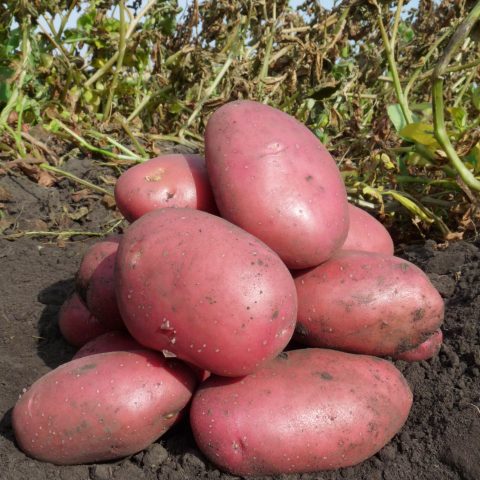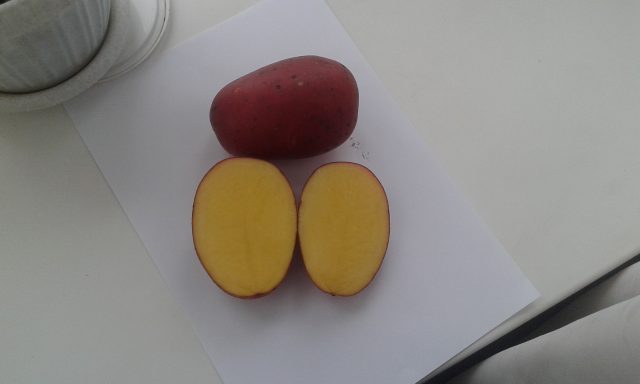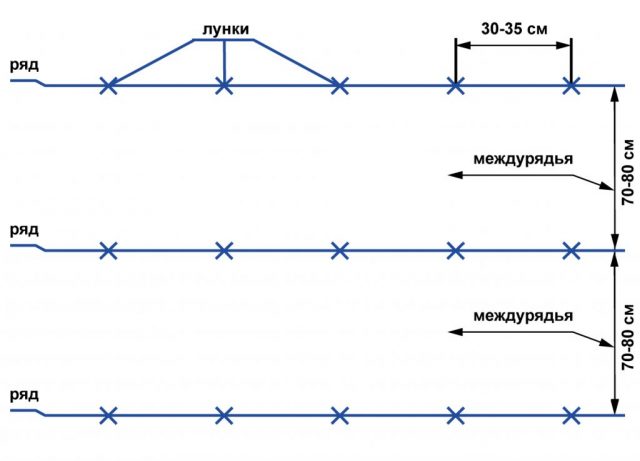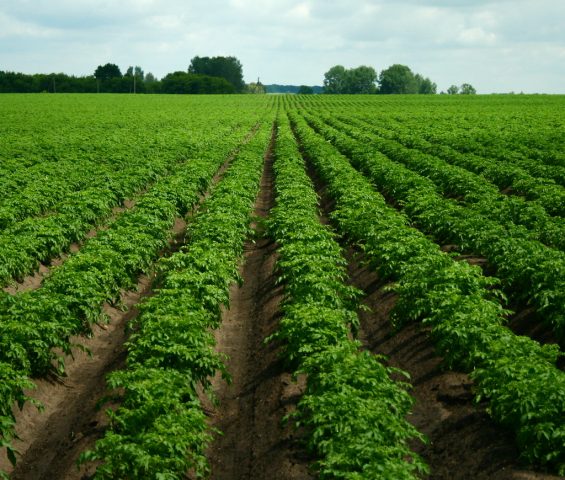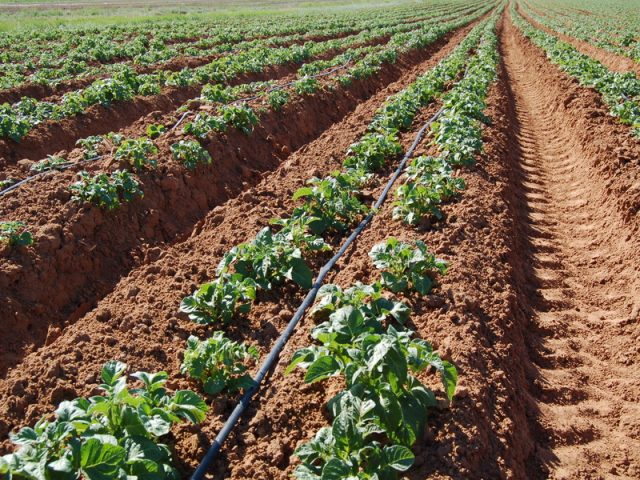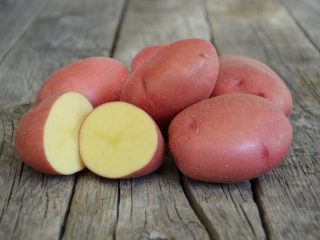Content
Baltic Rose potatoes are the development of breeders of the German company Norika. This variety is high-yielding and has increased resistance to diseases such as black leg, leaf roll virus. The Baltic Rose variety is one of the first candidates for inclusion in the State Register in 2019.The variety is popular among vegetable growers and can be found among the people under the name Red Gala.
Description of the potato variety Baltic Rose
According to the manufacturer's description and expert reviews, Baltic Rose potatoes (shown in the photo) are a mid-early variety with attractive bright red tubers.
Oval tubers have small eyes. The skin is red, smooth, and the color of the flesh is yellow.
The bushes are medium in height, reaching 50-60 cm. Potatoes bloom with white flowers, of which few are formed on the bush.
Potatoes sprout together, large tubers of the same size are formed underground. Due to the early appearance of the crop, this variety is used commercially.
Taste qualities of Baltic Rose potatoes
According to consumer reviews, the taste of this variety is excellent. In terms of starch content in tubers (12.5%), potatoes are medium starchy. This means that the potatoes can be fried, used for making salads, the tubers are not boiled, they keep their shape well when cutting.
Pros and cons of the variety
Any potato variety has advantages and disadvantages. Before purchasing planting material, it is recommended that you familiarize yourself with the characteristics of the variety, study the pros and cons of growing.
The main advantages of the Baltic Rose variety:
- attractive appearance;
- small eyes;
- approximately the same size of tubers (110-180 g);
- high productivity;
- does not boil over, therefore it is suitable for frying;
- good transportability;
- long shelf life;
- high resistance to diseases (virus Y, black leg, foliar twisting virus, late blight, rhizoctonia).
The disadvantages include the low starch content. Some people prefer boiled potatoes, which make a delicious soup, mashed potatoes. Baltic Rose is best used for frying and preparing salads.
Planting and caring for Baltic Rose potatoes
To get a high yield of Baltic Rose potatoes, it is necessary to adhere to the recommendations for planting and care.
Selection and preparation of the landing site
A site for planting potatoes should be chosen in the fall. Waterlogged and wetlands are not suitable for growing potatoes. Shaded areas prevent the formation of tubers, therefore, well-lit areas are chosen for planting potatoes. The land should be light, fertile. Heavy alumina is not used for potato cultivation.
If the groundwater is close to the surface, it is recommended to plant potatoes on ridges or ridges.
Autumn soil preparation consists in digging up the earth with a shovel or a mechanized walk-behind tractor. With increased acidity of the soil, which is easy to identify with special acid meters, lime is added to the ground. It is recommended to add 200-300 g of dolomite flour per 1 m² of the area. If the site is fertilized with manure or humus, simultaneous liming is not carried out.
Digging before winter can improve the composition of the soil, and is also one of the methods of controlling insect pests. Many larvae and beetles overwinter in foliage, in the thickness of the earth, therefore burning fallen leaves and deep digging lead to the fact that the pests end up on the surface and freeze out.
In the spring, the site is re-dug up, breaking up clods of earth. Additionally, mineral fertilizers and organic matter are introduced. On peat soils, humus and sand are added in equal parts, 1 glass of wood ash is added to the mixture per 1 m², 1 tbsp. l. potassium sulfate and 2 tbsp. l. superphosphate.
Preparation of planting material
Preparation of tubers for planting is carried out as follows:
- potatoes are sorted and calibrated;
- exposed to heat (germinated);
- treated with pest drugs and growth-stimulating substances.
Small tubers selected for planting show no less yield than large ones. Therefore, for planting, it is best to select small tubers with a mass of 50 to 80 g.
Cutting the tubers for planting is not recommended, because any wound is a gateway for disease. But if there is very little seed and it needs to be multiplied, tubers are divided. Potatoes weighing up to 100 g are cut lengthwise into two equal parts. If the tubers are large, they are cut into several parts, it is necessary to control that at least 2-3 eyes are present on the obtained shares. Cutting potatoes is done just before planting, this will help to avoid rotting and diseases of the tubers. The knife must be treated with formalin after each tuber.
Potatoes Baltic Rose begin to germinate 15-20 days before planting in the ground. In this case, the air temperature should be 12-16 ° C, humidity about 85%, and illumination 200-400 lux. High illumination is needed so that the sprouts do not stretch too much.
To prevent over-infestation of tubers during sorting, they are treated with fungicides Ditan, Polycarbacin, Fundazol, Prestige. At the same time, you can carry out the treatment with a growth stimulant. The soaking procedure in a stimulating solution is carried out 3-4 hours before planting the potatoes.
Landing rules
Many gardeners make a mistake when planting. Having a minimal area for potatoes, they place the tubers close to each other. Practice shows that the correct placement of the beds and the distance between the seeds play an important role in the formation of potatoes.
There are several popular schemes that can increase the yield of Baltic Rose potatoes.
Planting in rows or under a shovel is done as follows:
- Limit the area of the site with pegs, the height of which is equal to the width of the row spacing.
- Dig holes with a shovel, the distance between them should be about 30-35 cm.
- The depth of the hole depends on the quality of the soil. On sandy loam soils, potatoes are deepened to 10 cm, on loam, 5 cm is enough.
- It is more convenient to land together. One digs holes, the assistant pours fertilizer into the holes and neatly places the planting material.
- Sprinkle potatoes with earth from a neighboring hole.
- The adjacent row is placed at a distance of at least 70 cm from the previous one.
One of the disadvantages of this method is that during heavy rains, the potatoes in the ground will suffocate and begin to rot.
In regions with frequent and heavy rainfall, Baltic Rose potatoes are planted in the ridges. The tubers located in the ridges do not suffer from stagnant water. During rains, the water is drained into the aisles, so the potatoes do not rot.
When cutting the ridges, use a plow or cultivator. Between the ridges 60-70 cm are left, the height of the ridge is at least 15 cm. In the ridges, holes are dug 5 cm deep, the distance between the holes is 30 cm.
On sandy loam, sandy soils, this planting method is associated with one drawback: the ridges dry out quickly and, in the absence of precipitation, require additional watering.
In regions with rare precipitation, the Baltic Rose method of planting potatoes in trenches is used. In the fall, trenches up to 30 cm deep are prepared, manure, compost, and organic fertilizers are poured into them. Leave at least 70 cm between the rows.
In the spring, tubers are laid out in the grooves, leaving 30 cm between them. On top of the potatoes, they are covered with earth, mulching materials.
Watering and feeding
The first watering of Baltic Rose potatoes is carried out after sprouting. During the formation of bushes, the need for moisture increases. During budding, watering is required, otherwise the ovary will be shallow. The bushes are watered with warm water previously collected in a container. Watering is best done early in the morning or after sunset.
In large areas, the drip irrigation method is used.
Top dressing helps to increase the harvest of Baltic Rose potatoes. It is advisable to carry out this procedure three times:
- during the formation of bushes. For 10 liters of water, dilute 1 tbsp. l. urea. You can use 0.5 liters of mullein per 10 liters of water. Pour 0.5 liters of the nutrient mixture under each bush;
- during budding. It is necessary to dissolve 1 glass of wood ash in a bucket of warm water and pour 0.5 liters of the composition under each root;
- during flowering. 10 liters of water will require 2 tbsp. l. superphosphate and 1 glass of chicken manure. This solution is enough to feed 20 potato bushes.
If the area of the site is large, top dressing can be carried out with dry fertilizers.
Loosening and weeding
In the process of loosening, the roots are saturated with oxygen, and small weeds... The procedure is carried out carefully so as not to damage the sprouts and not expose the tubers. The first loosening is carried out one week after planting. In the future, loosening and weeding is carried out as needed: after watering and rains, with a strong growth of weeds.
Hilling
A simple procedure - hilling allows you to increase the yield of potatoes. This event is held 2-3 times per season. It is advisable to carry out the first hilling at the moment when the tops are stretched 15 cm. Around the bush, they rake damp earth with a hoe, and a small mound is obtained. The second time is spud no earlier than 2 weeks later. The third time is spud as needed.
Diseases and pests
The potato variety Baltic Rose is distinguished by good resistance to common diseases: black leg, Y virus, foliage virus. To protect against rot and insect pests, pre-planting treatment of tubers is carried out. When signs of late blight appear, spraying the bushes with copper sulfate is used.
With the invasion of Colorado beetles, they are harvested by hand; Fastak, Karate, Benzophosphate preparations are used for processing. You can arrange a trap for beetles: spread potato peelings, treated with chemicals, in the aisles.
To prevent the appearance of a wireworm, pre-winter digging of the site is mandatory.
Potato yield
The yield of Baltic Rose potatoes ranges from medium to high. In each bush, 10 to 25 tubers are harvested. The yield of the Baltic Rose variety depends on climatic conditions, as well as on timely fertilization and irrigation.
Harvesting and storage
Baltic rose potatoes are harvested in late July - mid-August. It all depends on the timing of planting and weather conditions in the region. After collecting potatoes, they are left in the shade to dry and weather, then they are sorted out and sent for storage. Decrease the temperature gradually. Small tubers for planting are selected immediately in order to shorten the time for the search for seed in the spring.
Conclusion
Potatoes Baltic Rose is a high-yielding variety that allows you to collect up to 2.5-3 kg of yield from each bush. Compliance with the rules of agricultural technology allows you to increase the yield indicator. Preventive treatment of seed material protects against various diseases and pests.
